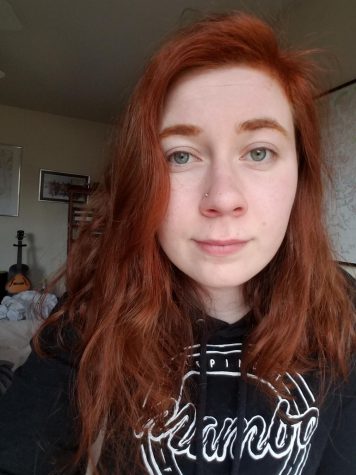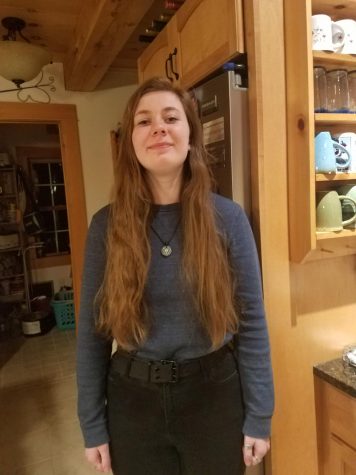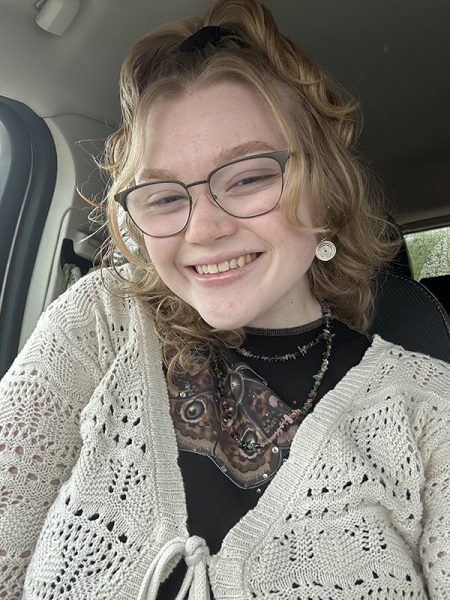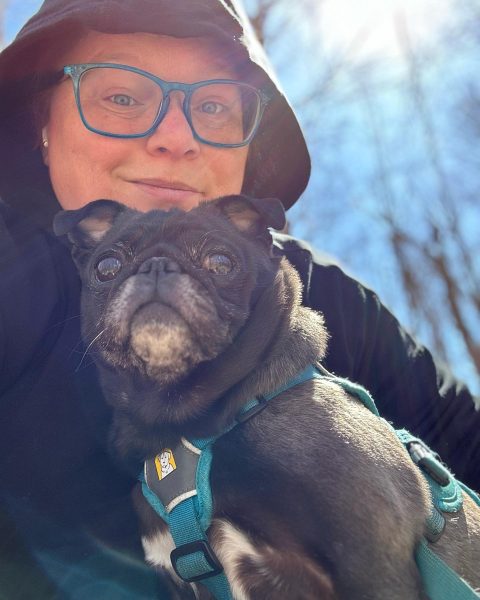Trying henna in her hair
Three days into social distancing from COVID-19 I started to go a little crazy. I had nothing new to do, was sick of watching Netflix and playing video games, and needed a bit of change in my life. Although classes were soon to start up, I had a week of figuring out what to do with myself that didn’t require going out into public.
As I thought about what I could do, I played with the ends of my hair, which hung all the way to my lap. I looked down and it hit me. I should change my hair.
I had been growing my hair out for six years and figured that maybe, amid the chaos of the world and the stagnant times I was soon to experience a little change would help me cope.
It also took a lot of maintenance to keep it looking nice and healthy.
I chopped off about ten inches, which brought it up to just below my shoulders. I had my mum cut it, because although I can do a quick trim myself, I didn’t trust myself with that much. Plus, my hair was part of my identity, so who knows if I would be able to go through with it. Once it was done, I felt like I needed to go even further.
As I looked at my new style in the mirror I thought, “Why not add some color?”
I had been thinking about dying my whole head of hair for a while. My natural hair color is very light brown, so it takes color pretty well without bleaching, a process I wouldn’t want to deal with. In high school, I played around with streaks of different colors like blue and firetruck red. Manic Panic was my brand of choice and I picked it up at my local Hot Topic outlet like the slightly band geek I was.
Since then, I’ve turned into quite the stereotypical Vermont hippie, only buying ethical and natural products. I’ve missed having red in my hair, so I figured if I could find a color that vibes with who I am, that would be ideal. Although Manic Panic is vegan, I wasn’t about to dye my whole head “vampire red” again; it just wouldn’t match my vibe.
I turned to henna dye.
Henna dyes come from the plant Lawsonia inermis, or the henna tree. It is made from the leaves, which are ground up into a paste or powder. One of the most popular uses of henna is for temporary tattoos, originally stemming from the ancient Indian art of mehndi. It is used by many Middle Eastern cultures as well in various modes of body art.
I looked on the internet to see which kinds were recommended and if I could get it through Amazon.
After watching a couple of YouTube reviews, I settled on the brand Light Mountain Natural. It appealed to me because the only ingredient on the label was the henna plant itself. There were no chemicals that were going to damage my freshly cut and healthy hair.
From the video, it seemed like the regular red color was going to get me the results I wanted, so I went ahead and ordered a pack. I paid $15 and some change for a pack of three boxes. The extra I figure will come in handy when I’m looking to touch it up. Each box also came with a pair of plastic gloves and a large baggie that could be used as a hair net.
It came as a green powder, and the instructions said to add boiling hot water to it, mix together, and let it cool for about half an hour before applying it to my hair. I made up some cheap black tea instead of water because the YouTube video suggested that it would come out slightly more brown and stay a little better if I did so.
The smell of the mixture reminded me of matcha or yerba mate mixed with a hay loft. It was interesting and very potent.
After I mixed it up, I covered it and washed my hair while it cooled. You’re supposed to apply the mixture to towel-dried hair.
I sectioned my hair into four layers and applied the mixture to my roots because they are the hardest parts to get thoroughly. Then I massaged it into my scalp for good measure and coated the rest of my hair.
I felt a little silly doing this because unlike regular hair dye, which is about the consistency of hand lotion, the henna is closer to the consistency of pancake batter or thick mud. By the time I had worked it all into my hair, it looked like a horse had diarrhea on my head, and it smelled similar.
I bundled my generously coated hair into a shower cap that I stole from a hotel a couple months ago in preparation.
I let it sit in my hair for five hours. The good news about social distancing is that no-one is going to see you looking your worst for the day.
It leaked out of the shower cap a fair amount over that time, so I recommend wrapping a towel around your neck to catch it all as I did. The mess was more controllable that way.
I took a shower to rinse it out of my hair, which took about half an hour. It was a very messy experience and smelled pretty disgusting. By the end, my hair was still bleeding a golden tea color, but I was sick of rinsing it, so I found a dark towel to dry it off with and called it a day.
I also added a little bit of my leave-in conditioner so my hair would be soft and healthy.
Once it dried a little bit, I looked in a mirror for the first time. (I’m all about the dramatic reveal.) I was in for a surprise. My hair had turned a bright orange-red and I laughed really hard when I saw it.
Henna tends to be very dramatic day one and then evens out to what it will actually look like about a day later. I waited 24 hours before I washed it with shampoo and conditioner like usual and there was a fair amount of bleeding of color, but not as much as I would have got with traditional hair dye.
I dyed my eyebrows for about two hours so that they would be closer to the same color, but they are darker than the rest of my hair, so it didn’t take very well over time.
About two days into having the color in my hair it took a darker, more neutral tone and it has stayed that color since. I am far happier with the tone that I am left with than that initial red shock.

This was a cool experience and I think if I dye my hair again it will be done using henna. I recommend henna hair dye to anyone who is looking for a natural experience and doesn’t mind smelling a little bit like a barnyard for a couple days.

Sophomore, Journalism
Grew up in Salisbury, NH
Fall 2018 - Present
The closest I have come to fame so far is once, at a Weird Al concert, he went...









